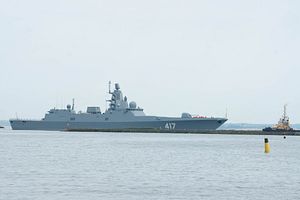In yet another sign that Russia’s ambitious naval rearmament program is facing difficulties, the head of the United Shipbuilding Corporation, Alexei Rakhmanov, announced that the delivery of the second Admiral Gorshkov-class (Project 22350) guided missile frigate, Admiral Kasatonov, will be delayed by around eight months.
“The second warship of this series, the Admiral Kasatonov, was due to have been delivered this year but considering that the ceremony of hoisting the flag aboard the [Admiral] Gorshkov has been postponed, we simply won’t be physically able to prepare the next ship,” Rakhmanov told TASS news agency last week.
“The delay with the delivery of the lead ship always automatically shifts the delivery of the second ship by about eight months. So, it turns out that we are now planning this for October-November 2019.” Originally, the Admiral Kasatonov was expected to be handed over to the Russian Navy already in February 2018, with the first round of sea trials supposed to kick off in the summer.
Meanwhile, sea trials of the first-of-class Admiral Gorshkov are ongoing. The warship is expected to be commissioned in November 2018. (It was originally supposed to be commissioned in November 2017). Russia’s Ministry of Defense, however, has so far not publicly announced a commissioning date and additional delays appear very likely.
The lead ship of the Admiral Gorshkov-class has been under construction for over a decade. The future stealth destroyer was laid down in 2006 and launched in 2010. It has been undergoing builder sea trials since November 2014 with a first commissioning date initially set for November 2016.
The Admiral Gorshkov-class has had to deal with various technical issues, including performance and compatibility problems with its Polimut Redut air defense missile system and with its propulsion system. The entire Project 22350 program also suffered from periodic funding shortages since its inception.
Displacing around 4,500 (standard) tons, the Admiral Gorshkov-class is the largest class of surface warships to be built by Russia since the collapse of the Soviet Union. It is a multi-purpose platform designed for anti-air, anti-surface, and anti-submarine warfare missions.
The ship’s primary weapon systems for anti-surface warfare missions will be the 3M-54 Kalibr, a stand-off supersonic anti-ship cruise missile with an estimated range of 270 to 410 miles, or alternatively the P-800 Oniks over-the-horizon supersonic anti-ship missile (or its more advanced derivative, the two-stage BrahMos missile) launched from vertical launch system cells. (The 3M-54 Kalibr is also available in land-attack and anti-submarine variants.)
Two additional Project 22350 frigates have been laid down in 2012 and 2013 respectively. However, given that the Russian defense industry is still struggling with designing a new propulsion system for the Russian Navy’s surface combatants as it can no longer rely on Ukraine-made gas turbine engines (it still had two Ukrainian engines for Gorshkov-class destroyers in stock), it is unclear when or if either of the two ships will enter service.
































